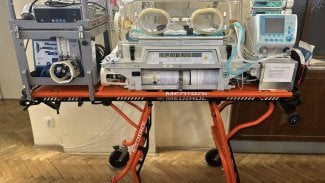Názory k článku Ext4: evoluční souborový systém
-
Článek je starý, nové názory již nelze přidávat.
-
alblaho (neregistrovaný)A pořád si musím při formátování říct, kolik budu potřebovat inodů? Nesnáším věštění budoucnosti. Je to ošklivá vlastnost, buď zbytečně překážejí, nebo dojdou.
Chápu výhody statického layout. Líbilo by se mi, kdyby šly nové inody přidat. V případě, že by došly, vytvořil se nějaký speciální soubor a nové inody uložily do něj. -
Sten (neregistrovaný)
Neumí. Viz Wikipedie:
Max number of files: Set at filesystem creationNa ext4 Wiki se dokonce píše:
The number of inodes in the system can not be changed after the filesystem is created, at least without growing the filesystem. If the filesystem is grown using resize2fs (wihch requires increasing the size of the partition or logical volume on which the filesystem resides, of course), the number of inodes in the filesystem will grow, but only in rough proportion to the number of blocks in the filesystem.
The proportion of inodes to disk space available is controlled by the -i option to mke2fs.
There is no harm in creating too many inodes, except that time to fsck the filesystem will grow a small amount, and space that could be used for file storage will be reserved for the inode table.
Jinak používám ext3 i ext4 a nikdy mi inody nedošly. Žádná vlastní čísla jsem nezadával. mke[234]fs to nějak dobře odhaduje.
-
Mard (neregistrovaný)IMHO aby došli inody, tak musí být splněny následující podmínky. Nesmí být na disku velký počet linků a musí tam být abnormálně velký počet malých souborů. Tj. když někdo připravuje disk na nějaké výsledky opakovaného měření, nebo fotky z webcam, což jsou příklady malých souborů v obrovském počtu, tak pochopitelně dá při vytváření velký počet inodů, jinak je to moula. V opačném případě je to jedno, pár inodů navíc nevadí (při velkosti dnešních disků) :-)
-
anonymníJen doplním .. (korekce v hranatých závorkách):
"nenarazil na nic[,] co by mu bránilo v práci."
"Ext4 přichází se spoustou vlastností zlepšující[ch] výkon a omezující[ch] fragmentaci." (předpokládám více vlastností, ne jednu)
"a některé byly dokonce implementovány, ale další nikoli[,] a začalo se mluvit o vytvoření další verze ext"
"kdyby ext3 zůstalo stabilní a nové vlastnosti se implementovaly až do ní" (já nevím, připadne vám ideální měnit dva rody v jednom souvětí? :) )
"Poráží i starý limit maximální velikosti oddílu, který má ext3 na hodnotě 16 TiB[,] při velikosti 8 KiB na jeden blok." (předpokládám limit 16TiB na ext3)
"kdy se do souboru zapsalo spousty nul" (zapsaly spousty / zapsalo hodně)
"dovoluje programům odeslat hodně bloků najednou[,] na rozdíl od existujícího mechanismu v jádře" (tady si nejsem jist)
"se k sekundové části přidaly 2 bity navíc[,] a tím se posunul" (příslovečná účelová?)
"Této struktury budu dále využít u testů s kompresí" ([využívat]?)
"Pro tento test jsem se rozhodl použít film Big Buck Bunny[,] s celkovou velikostí asi 200 MiB[,] a Elephants Dreams[,] s velikostí 800 MiB."
Pokud jsem se někde sekl já, opravte mě, tohle jsem bral naposledy někdy na základce.. -
JardaP (neregistrovaný)Tak to vypada, ze po uvezneni Reisera tu mame dalsi skutecnosti, ktere zlikviduji ReiserFS. Jsou-li testy spravne a s podobnymi vysledky reprodukovatelne na jinych masinach, Ext4 se na FeiserFS svymi parametry tesne tlaci nebo ho preci. Mizi tedy duvod pouzivat ReiserFS tam, kde mel sve vyhody, napr. pri praci s hafem malych souboru. Samozrejme, otazka je, jak to bude vypadat v praxi, s opravdovymi daty.
-
Uživatelka si přála zůsta (neregistrovaný)Nemám čísla, ale když máte například omezený prostor pro systémovou particii tak to docela poznáte. Na internetu se dají anlézt benche; v některých případech asi halvně ze serverového nasazení se dají najít katastrofické případy :) jako 250MB proti 4780MB a tak... to ale musel být nějaký extrém.
-
miguel23 (neregistrovaný)ja nevim, co je ted za modu vsude roztrubovat ze reiserfs (takze verse 3.6) je mrtvej. Cloveka, ktery uz o ten filesystem nekolik let nema zajem zavreli. No a co jako. Dulezite je, ze to je stabilni kod, je udrzovany a je v jadre. S reiserem4 to vypada blede, ale to je _jiny_ filesystem a jina kapitola. Tak uz to neplette dohromady.
-
Michal Kubeček (neregistrovaný)
Jádro 2.6.23 přidává další 2 bity k timestampu v systému a tohoto vylepšení využívá i ext4. To pak může ukládat čas s přesností na nanosekundy.
Tady se asi vloudila nějaká chyba. Dva bity by na nanosekundovou granularitu nemohly stačit, na to je jich potřeba aspoň 30.
-
Daniel R (neregistrovaný)Ahoj, ext3 muzes pripojit jako ext4 a existuje moznost (mount option) zda chces nebo nechces pouzivat extenty. Pokud ne, tak tvuj FS zustane ext3 ale nevytezis nic z tech novych featur. Pokud extenty povolis tak nove soubory budou alokovany novym zpusobem a tvuj FS jiz jako ext3 nikdy nepripojis. Ta "zpetna kompatibilita" je tedy spis veci toho, ze nemusis mit ext2/3/4 drivery ale bude stacit jen jediny - ext4 driver.
-
Uživatelce zkrouhli nick (neregistrovaný)Tak to máte blbé, protože spolehlivé smazání nemá žádný FS - vyžaduje to totiž kompletní přepsání všech bloků (a pro extrémně paranoidní vícekrát, aby to nešlo přečíst v laboratoři), na což se každý rozumný FS vykašle (u toho péčka to budou řádově stovky MB). Spolehlivé mazání patří mimo FS, speciálním utilitám.
-
bim (neregistrovaný)Tak ted si nejsem jist, zda se navzajem chapeme. Proto radeji napisu, ze OpenVMS neni jedna z distribuci linuxu, dokonce to ani neni system unixoveho typu. Se souborovymi systemy linuxu pracovat neumi, stejne tak jako linux neumi plnohodnotne pracovat se souborovym systemem ODS-2 z OpenVMS.
Jinak viz napr. http://en.wikipedia.org/wiki/OpenVMS -
anonymníTak si to pořádně nastavte. Na mém Linuxu může své soubory mazat, zálohovat i obnovovat ze zálohy i běžný uživatel. A pokud "houska" namítal, že podpora pro undelete ve FS řeší problém nespolehlivého uživatele, tak v mém scénáři (uživatel má své soubory, které může mazat, zálohovat i obnovovat) tomu tak opravdu je a není k tomu třeba žádného admina.
-
WHS (neregistrovaný)"nevychovaný spratek" - asi další nadávka na mou adresu, já za celou dobu na tvou nenapsal ani jedinou. Ta spousta nadávek na mou hlavu jen proto, že ti odmítám splnit dětinské přání - vykat ti. Uvědomuješ si, že se jako anonymní internetový diskutér se oháníš silnými slovy, nadávkami a ještě tu kážeš o slušném chování ?
-
anonymníNemám pocit, že bych byl v diskuzích neslušný, snažím se k ostatním chovat s respektem a diskutovat věcně, s ověřitelnými argumenty.
Možná vám vadí, že nejsem politicky korektní a když někdo lže, nazvu ho lhářem, když se někdo chová jako hulvát, nazvu ho hulvátem. Nemám pocit, že by to ale bylo v rozporu s tím, co jsem uvedl v prvním odstavci.
K tomu "aneb" - buďte prosím konkrétní a zkuste polopaticky, nejlépe na reálném příkladu, uvést, co tím vlastně myslíte. -
anonymníNe, opravdu jsem si nevšiml toho, aby si neznámí lidé tykali na netu na diskuzi, zvláště když s tím má někdo problém. Já jsem byl vychován tak, abych se k ostatním choval slušně a respektoval druhého. Pravda je, že v dnešní době slušnost vůbec není kůl a in, zvláště mezi pubertální mládeží.
Žádal jsem o konkrétní příklad, zase jsem dostal nějaké neurčité plácnutí do vody. Že mně to ani nepřekvapuje... -
anonymníTo je asi stejná otázka, zda je v osobním kontaktu možné vykat konkrétní osobě, která se nepředstavila. Ano, je a dělám to běžně. Třeba včera při nákupu mně oslovil pán a ptal se na zboží, které jsem kupoval, zda s ním mám zkušenost a jakou. Oba jsme si vykali, přestože jsme oba byli vzájemně anonymní, neznáme se, nikdy jsme se neviděli a asi ani neuvidíme. Základní prvky slušnosti nejsou vázány na to, jak dobře znám někoho jiného.
-
anonymníObávám se, že si pletete pojmy s dojmy. Anonymita je utajení totožnosti osoby. Takže i v případě, že někoho potkám tváří v tvář, může taková osoba být anonymní. Mám sice k případnému odhalení totožnosti blíže, než když se s takovým člověkem setkám v diskuzi na netu, ale pořád to ještě neznamená, že tím, že ho vidím, nemusí být anonymní.
Máte-li dojem, že se pletu, uveďte vlastní definici pojmu "anonymní osoba". Děkuji. -
arnold (neregistrovaný)Pro mne je míra anonymity funkcí utajenosti informací o osobě a vnímám ji jako veličinu spojitou. Beru to tak, že pokud se s někým setkám tváří v tvář - pak znám datum, čas, pohlaví, vzhled, postavu, barvu hlasu, přibližné stáří, kus konkrétního relevantního rozhovoru, možná i část povahy atd... Pokud by o něco opravdu šlo, bylo by možné toho člověka dohledat, protože mám dost informací k jednoznačné identifikaci jedince. Jméno je už jen taková třešnička na dortu. Naopak u anonymního přispěvatele v diskusi se kromě vlastního textu nemáte od čeho odrazit, pokud navíc použil nějakou proxy...
-
anonymníNemám pocit, že by vaše vyjádření bylo konzistentní. I pokud se s někým nesetkáte tváří v tvář, ale "potkáte" ho třeba v anonymní webové diskuzi, máte datum, čas, pohlaví, kus konkrétního relevantního rozhovoru a možná i část povahy. Nicméně to jsou všechno atributy dané osoby, v žádném případě ne její identita. Pokud jako identitu jedince berete i to, jakou má barvu vlasů, hlasu a jak je vysoký, potom se asi těžce míjíme.
-
anonymníČekal jsem, kdo se toho chytí.
Když o sobě někdo píše jako -la, bude to asi ženská, když jako -l, bude to asi chlap. Na 100% to není nikdy, stejně jako při osobním kontaktu.
Když někdo ve skutečnosti vypadá jako ženská, je docela velká šance, že to ženská bude. A naopak. A to přesto, že se můžete šeredně mýlit. Jako extrémní příklad mohu doporučit, abyste si zajel do Thajska, kde objevíte tranvestity chlapy, u kterých byste se vsadil, že jde o ženské.
Pokud nesouhlasíte, odpovězte mi na otázku, jak chcete určit pohlaví při osobním kontaktu. Bez ukazování občanky. -
Uživatelka si přála zůsta (neregistrovaný)Ne vždy. A když je tu možnost obnvit dejme tomu v 30 procentech případů, tak to stojí za to. Navíc, systém copy-on write by právě tohle podchytil.
Jinak týpky co odmítají undelete nechápu. Když chcou po sobě zničit stopy, stejně to musí mazat speciálním způsobem, tak proč neudělat běžné mazání recover-friendly? Třeba jako implementovat koš na úrovni alokační tabulky (a přepisovaly by se bloky nejstarších smazanců). -
Uživatelce zkrouhli nick (neregistrovaný)Nene, koš v OS je právě hloupost. Představte si to na VFAT: smazání proběhne tak, že se v FAT tabulce a directory entries soubor označí jako volné místo. No a místo tohoto flagu by se tam mohl dát jiný, který by ozančoval něco jako podmínečné volné místo. Tudíž by se s tímto smazaným souborem normálně kalkulovalo jako s volným místem, nicméně by stále byl snadno obnovitelný. A když by bylo třeba alokovat nějaké místo, FS by přepsal nejstarší podmínečně samzané soubory. Funkce je úplně stejná jako v případě přímého smazání, bezpečnsot samzání je de facto úplně stejná (= žádné bez přímého přepsání bloků), obnovitelnost je bonusem.
-
Radek Tondra (neregistrovaný)No to je ale samozřejmě blbost. O principu filesystému očividně nevíte vůbec nic.
Protože soubor není jen directory entry, ale především mnoho záznamů v tabulce alokace clusterů. Při smazání souboru se tedy nejen nuluje první znak souboru, ale především spojový seznam alokovaných clusterů.
Abychom umožnili obnovení souboru, nesměli bychom v této tabulce nic mazat. Po určité době práce s diskem by se nedaly najít žádné vynulované záznamy.
Pak bychom před každým zápisem museli najít nejstarší smazaný soubor, vynulovat jeho seznam clusterů, zkusit zápis a pokud by to nestačilo, tak toto opakovat. To by bylo tak brutálně pomalé, že byste určitě raději ten snadný undelete oželel. -
rhn (neregistrovaný)Dakujem za bohatu diskusiu na moj dotaz. Rad by som reagoval na niektore nazory.
1. Nemal som na mysli ani tak utilitu - co je zalezitost balikov, ale sposob alokacie novych blokov, aby sa snazil nevyuzivat nedavno zmazane subory (prioritna alokacia davnejsie zmazanych suborov).
2. V ramci popularizacie Linuxu nie je vhodne tvrdit ze undelete je nanic a treba to riesit zalohovanim. To je pekne, ale castokrat si niekto nainstaluje linux a potom takyto argument ho presvedci aby sa vratil k oknam, kde takych utilit ma moc. Ono je aj tazke pre uzivatela si vymedzit predmet zalohovania, lebo uzivatel pracuje len nad urcitou abstrakciou - ked sa ho spytate kde je subor, povie ze ked si spusti office tak je tam.
3. Vacsinou nepouzivam desktop (a ked ano, najviac xterm) - kos mi neriesi moj problem. Navyse sa vacsinou dostavam len k strojom, ked uz problem vznikol a nemal som vplyv na to obist ho.
Priklad: Nedavno sa stalo kamaratovi, ze mu nejaky skript na postovom servery vyliezol z adresara a pomazal mu nieco v home-och. Dany skript (v perle) stiahol z internetu ako pouzivanu zalezitost vhodnu pre postfix - na mazanie maildirov neexistujucich uzivatelov (odstranenych). Fungovalo mu to 6 mesiacov a potom mu to zmazalo aj co nemalo. Problem zistil okamzite, ale obnova na ext3 uz nebola mozna. -
Yenya (neregistrovaný)To ale resite problem opozdeneho zapisu, ne opozdene alokace. Ta se navenek (z hlediska disku) projevuje stejne jako opozdeny zapis - jen _kam_ se bude zapisovat se urcuje az tesne pred zapisem (coz ale je jen interni optimalizace v pameti, z hlediska padu systemu pri vypadku napajeni se to chova stejne).
-Yenya, http://www.fi.muni.cz/~kas/blog/ -
anonymníSe %subj% jsem měl velké problémy v ext3. Typické nasazení - IMAP server s maildirem, tisíce souborů v každém adresáři. Tam měl ext3 velmi významné problémy s výkonem - ačkoliv "cachoval" do giga paměti, nestačilo mu to a otevírání poštovní schránky trvalo nezřídka i minutu a více, za neustálé práce disků v RAID5 poli. Po změně souborového systému na XFS najednou problém zcela vymizel a to přes to, že od té doby přibylo celkem dost dalších mailů = souborů. To samé adresář s portage v Gentoo - desítky tisíc malých souborů a neuvěřitelně neefektivní práce s nimi. Jsou v tomto směru v ext4 nějaká zlepšení? Z popisu a zpětné kompatibility se obávám, že nikoliv.
-
K. (neregistrovaný)Nějak jsem se ztratil v tom, co má EXT4 umět navíc oproti EXT3. Například zvládá větší oddíly. Tedy větší než 16TiB, které uměl EXT3. Ano, to vypadá jako výhoda až do chvíle, než autoři prohlásí, že takový velký oddíl vytvoření s EXT4 bude možné bez problémů namountovat a používat jako EXT3.
A tak je to i s dalšími "rozdíly". Tady v této správičce to ještě není dotažené do absurností, ale v některých článcích co teď vychází je opravdu většina výhod prezentována jako "EXT4 umí navíc i tohle a nejlepší na tom je, že to jde použít i s EXT3".
Kde tedy dělám chybu? Když věřím, že EXT4 umí něco víc, nebo když věřím, že "Stále se daří udržet dopřednou a zpětnou kompatibilitu, takže ext3 může uživatel připojit jako ext4 a obráceně."
Osobně to chápu tak, že EXT4 bude dopředně kompatibilní (tedy EXT4 mountovatelná coby EXT3) jen pokud jste ji vlastně nepoužili.
-
anonymníStačí si přečíst jiné komentáře v diskuzi -- s driverem pro Ext4 připojíte i Ext3 a dokud nezačnete používat nové vlastnosti, zůstává FS jako Ext3 (máte výhodu kompatibility, ale nemáte nove vlastnosti Ext4). Jakmile použijete nové vlastnosti Ext4, ztrácíte zpětnou kompatiblitu -- je to jako vždycky něco za něco, hlavní smysl je v tom, že si můžete vybrat.
-
K. (neregistrovaný)No, na internetu je okolo toho více diskusí a je tam běžně i dotaz jak to bude se záchranou takových oddílů na havarovaných systémech a odpověď je, že díky kompatibilitě prostě nabootujete počítač z nějaké Live distribuce, která obsahuje EXT3 ovladač, a ona bez problémů dokáže pracovat i s diskem havarovaného počítače s oddílem EXT4. Nikde se nic netvrdí o tom, že by dopředná kompatibilita byla podmíněna tím, že oddíl byl vytvořen jako EXT3. Naopak je tvrzeno, že si vytvoříte oddíl od samého počátku jako EXT4 a přesto s ním dokáže EXT3 ovladač pracovat.
A co se týká "dokud nezačnete používat nové vlastnosti" pak 1. proč bych tedy přecházel na EXT4, když nechci používat jeho nové vlastnosti a 2. nejsem odborník na filesystémy, ale nebudou tyhle nové vlastnosti používané tak nějak automaticky bez mého zásahu (pokud je tedy již na začátku nezakážu, což jsme zpět u otázky 1). -
martin (neregistrovaný)> Linux se dostává do velmi specifických zařízení a občas některé z těchto
> zařízení potřebuje přesnější čas než vyjádření timestampu po vteřinách. Jádro
> 2.6.23 přidává nanosekundy ke stávajícímu timestampu v systému a tohoto
> vylepšení využívá i ext4. Jako přídavek se k sekundové části přidaly 2 bity
> navíc a tím se posunul problém roku 2038 o dalších 500 let.
Nejrozšířenější FS ukládá čas souborů s rozlišením 100 nanosekund už asi 15 let a ext4 má "novinku" 34-bit. No to tedy fůůůůůj ...
> Ext4 také řeší nově prealokaci bloků pro jeden soubor. Doposud se pro tuto
> činnost používala metoda, kdy se do souboru zapsalo spousty nul a tím se
> alokovalo potřebné místo navíc. Do ext4 bylo kvůli tomuto problému přidáno nové
> systémové volání preallocate(). Takto alokované místo by nemělo být
> fragmentované. Toto velmi ocení databázové systémy a také programy pro záznam
> různých audio a video přenosů, které ukládají data postupně podle toho, jak
> přijdou.
Na blití ... Nejrozšířenějšímu FS prostě řeknete, jak má soubor být veliký a ono se tak stane.



















